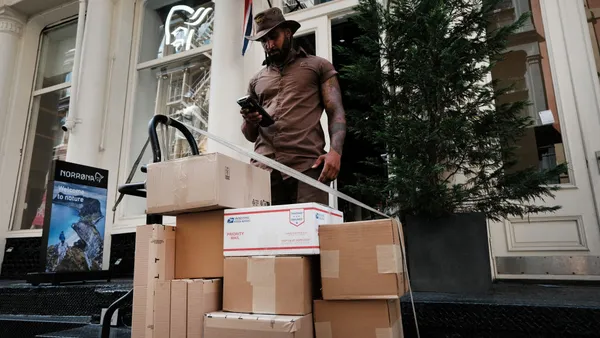Dive Brief:
- Reducing delivery costs is "a top priority" for Macy's after expenses shipping to customers equaled 5.9% of its net sales in Q4, CFO Adrian Mitchell said on a February earnings call.
- Carrier holiday surcharges contributed to the roughly $511 million total, Mitchell said. These surcharges were "essentially non-existent in 2019," he added.
- Macy's will reduce the number of split shipments, improve in-store fulfillment efficiency and get smarter about inventory placement to offset the costs, according to Mitchell.
Dive Insight:
Macy's and other retailers are wrestling with how to keep delivery costs at a manageable level while fulfilling more e-commerce orders. It's become a difficult problem to solve in an era of heightened home delivery demand that has tilted pricing power to the carriers.
UPS, one of the parcel carriers Macy's uses according to the retailer's website, hiked some of its domestic surcharges ahead of the 2021 peak season and recently implemented a 5.9% general rate increase. Demand isn't expected to fade this year.
"The small package market is expected to grow about 5% in 2022," UPS CEO Carol Tomé said on a February earnings call. "There is additional capacity being added, but not enough. That's going to create surplus. So the environment supports firm pricing as we look to 2022."
Executives flagged high delivery expenses during the 2020 peak season, too, and noted they were working to improve inventory placement and reduce split shipments, or the number of packages a customer receives for their order. Progress has been made — Mitchell noted that Q4 delivery expenses as a percentage of net sales fell YoY — but Macy's isn't done yet.
"So as we think about inventory allocation and our replenishment strategies, we're using data science to just better align where the demand is by channel and location across the country with where we're actually placing the appropriate level of inventory all the way down to an item level," Mitchell said.
Placing inventory closer to the end customer will be critical for Macy's as it uses its stores as fulfillment hubs for online orders. Last year, Mitchell said Macy's would test more efficient fulfillment operations at a small number of its stores that would include "varying levels of automation" to support ship-from-store and store pickup capabilities. On February's call, Mitchell said the results pleased the company and it would roll out the initiative to 35 more locations before the end of the year.
Although 2022 is shaping up to be another expensive year for parcel shippers, those offering buy online, pick up in store options will have an edge in terms of delivery costs, according to a Transportation Insight report.
"These could be the only way consumers can benefit from 'free shipping' instead of receiving items at their front doors for free," according to Transportation Insight. "Shippers will struggle to offer 'free shipping' beyond curbside and BOPIS thanks to higher shipping costs."
Editor's note: This story was first published in our Logistics Weekly newsletter. Sign up here.














